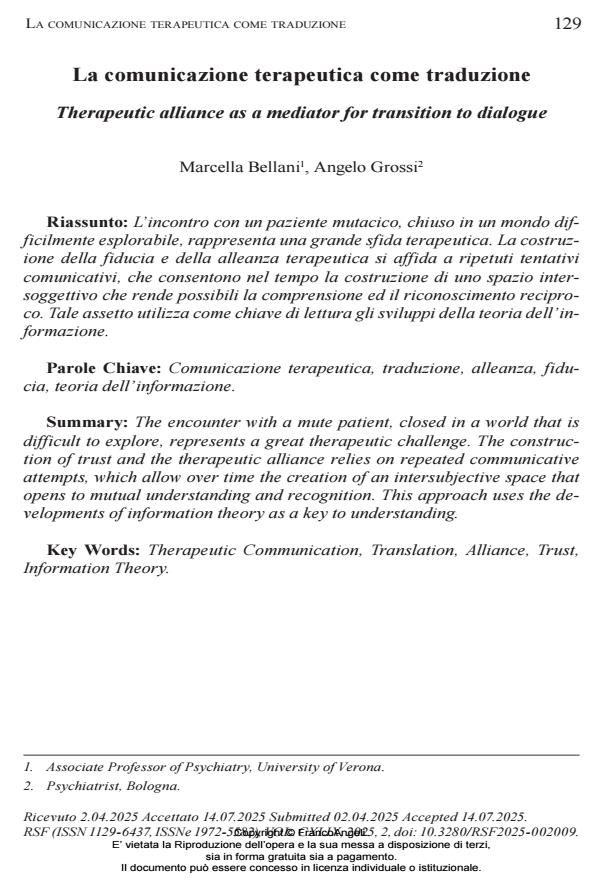Therapeutic alliance as a mediator for transition to dialogue
Journal title RIVISTA SPERIMENTALE DI FRENIATRIA
Author/s Marcella Bellani, Angelo Grossi
Publishing Year 2025 Issue 2025/2
Language Italian Pages 19 P. 129-147 File size 325 KB
DOI 10.3280/RSF2025-002009
DOI is like a bar code for intellectual property: to have more infomation
click here
Below, you can see the article first page
If you want to buy this article in PDF format, you can do it, following the instructions to buy download credits

FrancoAngeli is member of Publishers International Linking Association, Inc (PILA), a not-for-profit association which run the CrossRef service enabling links to and from online scholarly content.
The encounter with a mute patient, closed in a world that is difficult to explore, represents a great therapeutic challenge. The construction of trust and the therapeutic alliance relies on repeated communicative attempts, which allow over time the creation of an intersubjective space that opens to mutual understanding and recognition. This approach uses the developments of information theory as a key to understanding.
Keywords: Therapeutic Communication, Translation, Alliance, Trust, Information Theory.
- [1.] Bettini M. Vertere. Un’antropologia della traduzione nella cultura antica. Torino: Einaudi; 2012.
- [2.] Simard S. L’albero madre. Alla scoperta del respiro e dell’intelligenza della foresta. Trad. Albesano S. Milano: Mondadori; 2022. (Orig. Finding the Mother Tree. New York: Knopf Doubleday; 2021).
- [3.] The New York Times. Tree communication and mycorrhiza explained. The New York Times. https://www.nytimes.com/interacti- ve/2020/12/02/magazine/tree-communication-mycorrhiza.html [consultato 20 dicembre 2024].
- [4.] Guizzo EM. The essential message: Claude Shannon and the making of information theory. Thesis (S.M. in Science Writing). Massachusetts Institute of Technology, Dept. of Humanities, Program in Writing and Humanistic Studies; 2003.
- [5.] Kustvedt S. Le illusioni della certezza. Torino: Einaudi; 2018.
- [6.] Shannon CE, Weaver W. The Mathematical Theory of Communication. Urbana–Champaign: University of Illinois; 1949. Trad. it.: La teoria matematica delle comunicazioni. Milano: Etas Kompass; 1971.
- [7.] Clausius R. Théorie mécanique de la chaleur. Parigi: Lacroix; 1868. Disponibile su: https://gallica.bnf.fr/ark:/12148/bpt6k115792 [consultato 20 dicembre 2024].
- [8.] Clausius R. Vorlesungen über Gastheorie. Parigi: Gauthier-Villars; 1922.
- [9.]Boltzmann L. Modelli matematici, fisica e filosofia. Scritti divulgativi. A cura di Cercignani C. Torino: Bollati Boringhieri; 1999.
- [10.] Gelo OC, Salvatore S. A dynamic systems approach to psychotherapy: a meta-theoretical framework for explaining psychotherapy change processes. Journal of Counseling Psychology. 2016;63(4):379–95.
- [11.] Watzlawick P, Beavin JH, Jackson DD. Pragmatica della comunicazione umana: studio dei modelli interattivi, delle patologie e dei paradossi. Roma: Astrolabio; 2008.
- [12.] Robert JS. Embryology, Epigenesis and Evolution. Taking Development Seriously. New York: Cambridge University Press; 2004.
- [13.] Prigogine I. La fine delle certezze. Torino: Bollati Boringhieri; 1997.
- [14.] Castellano LA, McNamara RJ, Pallares HM, Gamarnik AV, Alvarez DE, Bazzini AA. Dengue virus preferentially uses human and mosquito non-optimal codons. Molecular Systems Biology. 2024;20:1085– 1108.
- [15.] Fields RD. A random influx of DNA from a virus helped vertebrates become so stunningly successful. Scientific American. 2024 Apr 12.
- [16.] Ghosh T, et al. A retroviral link to vertebrate myelination through retrotransposon-RNA-mediated control of myelin gene expression. Cell. 2024;187(4):814–30.
- [17.] Binder EB, Nemeroff CB. The CRF system, stress, depression and anxiety—insights from human genetic studies. Molecular Psychiatry. 2010;15(6):574–88.
- [18.] Borges JL. Finzioni. Milano: Adelphi; 2015.
- [19.] Kegl J, Senghas A, Coppola M. Creation through contact: sign language emergence and sign language change in Nicaragua. In: DeGraff M, editor. Language creation and language change. Boston: MIT Press; 1999.
- [20.] Pinker S. L’istinto del linguaggio. Milano: Mondadori; 1998.
- [21.] Keller E. The Mirage of a Space Between Nature and Nurture. Chicago: University of Chicago Press; 2011. DOI: 10.1215/978082239281
- [22.] Bollettieri RM. James Joyce and the trans-creation of the word. In: Bertuccelli M, Bertacca A, Bruti S, editors. Threads in the complex fabric of language. Linguistic and literary studies in honour of Lavinia Merlini. Pisa: Felici; 2009. p. 59–68.
- [23.] Vieira ERP. Liberating Calibans. Readings of Antropofagia and Haroldo de Campos’s Poetics of Transcreation. In: Bassnett S, Harish T, editors. Post-Colonial Translation: Theory and Practice. London: Routledge; 1999. p. 95–113.
- [24.] Benjamin W. Il compito del traduttore. Trad. di Costa MT. Milano: Mimesis; 2023.
- [25.] Vaswani A, Shazeer N, Parmar N, Uszkoreit J, Jones L, Gomez AN, et al. Attention is all you need. In: Advances in Neural Information Processing Systems. San Francisco: Curran Associates Inc.; 2017.
- [26.] LeCun Y, Bengio Y, Hinton G. Deep learning. Nature. 2015;521(7553):436–44.
Marcella Bellani, Angelo Grossi, La comunicazione terapeutica come traduzione in "RIVISTA SPERIMENTALE DI FRENIATRIA" 2/2025, pp 129-147, DOI: 10.3280/RSF2025-002009